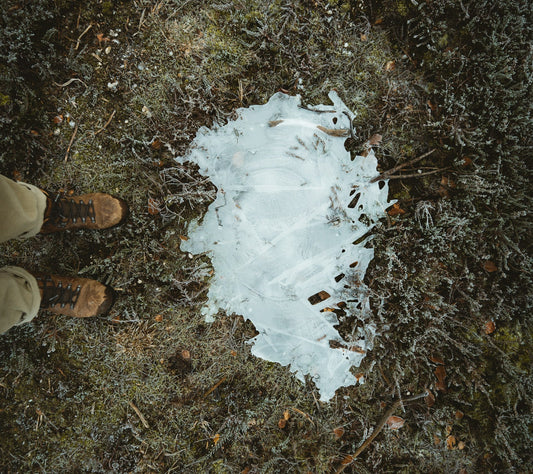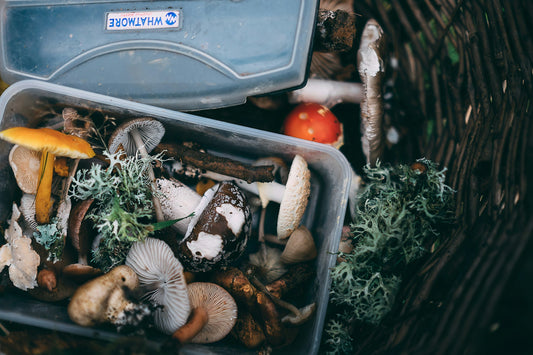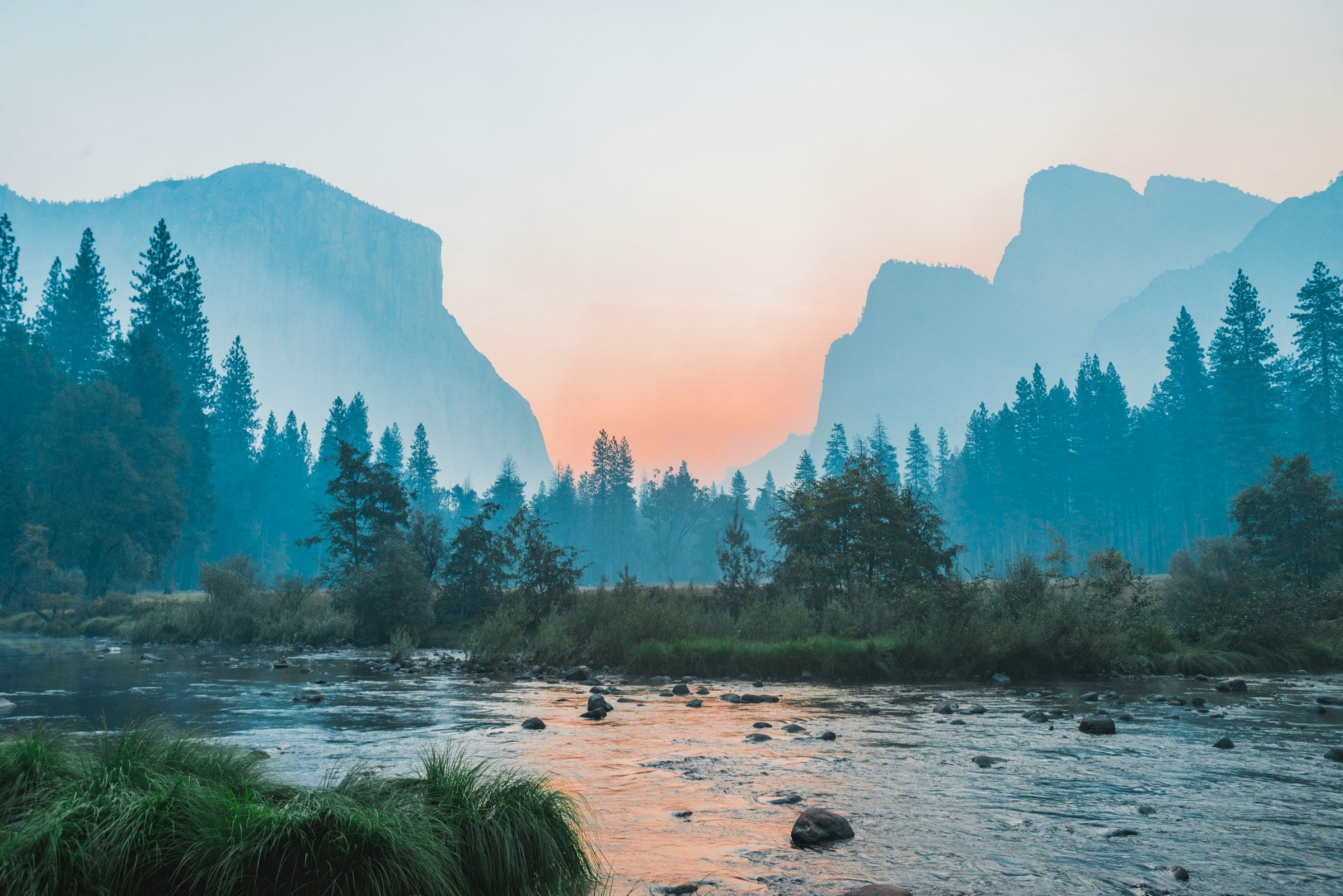
The 5 Cs of Survival
Discover the essential items needed to survive in the wilderness
What are the 5 Cs of Survival?
Outdoor aptitude and knowledge will always be essential for surviving in the wild, but knowing what to carry with you when you head into the unknown can also mean the difference between life and death.
Used as a benchmark by bushcrafters and survivalists all over the world, the '5 Cs of Survival' are a tried and tested list of essential items to have on you when venturing into the wilderness.
The 5 Cs are:
- Cutting tool
- Combustion device
- Cover
- Container
- Cordage
Let's explore these in more detail.
1. Cutting tool
You should never venture into the wild without the right cutting tool. Your cutting tool is essential for preparing food, building shelter, and - if you’re ever in a pinch - self-defense. It’s the emergency tool you can’t live without.
Standard cutting tools include:
- Bushcraft Knife. A bushcraft knife is a purpose-built tool crafted for survival and outdoor pursuits. Usually featuring a full-tang construction, these knives excel in various tasks crucial for wilderness living. From carving and whittling to shelter building and food preparation, a bushcraft knife is the go-to companion for outdoor enthusiasts and survivalists.
- Survival knife. Also known as a tactical knife, Bowie knife, or “Rambo” knife, you require this as the bare minimum for any survival situation. A full-tang survival knife is usually the best type of blade for this role.
- Hand axe. A small axe can be an incredibly useful tool for chopping firewood, and can even be used in place of a survival knife for smaller tasks if the user is experienced enough with an axe.
- Hatchet. Hatchets, while fulfilling a similar role to axes, are shorter and more lightweight. They also have a hammer on the opposite side of the blade, making them more multi-purpose.
- Multitools. For low-risk camping activities, a good quality multitool might serve as a sufficient cutting tool.
- Folding saw. Compact and lightweight, a folding saw is a great companion for long treks where you want to keep your pack weight to a minimum.
Choose yours
-
Full-Tang Bushcraft Knife
Regular price $69.99 USDRegular priceUnit price / per -
Stainless Steel Camp Knife
Regular price $34.99 USDRegular priceUnit price / per -
 Sale
SaleWilderness Folder
Regular price $59.99 USDRegular priceUnit price / per$79.99 USDSale price $59.99 USDSale -
Woodland Folding Saw
Regular price From $24.99 USDRegular priceUnit price / per
2. Combustion device
Campfires are an essential means of keeping warm and preparing food when exploring the wilderness. And lighters and standard matches are far from a foolproof solution to starting a campfire. This is because they can easily become wet, rendering them useless.
Finding the right sure-fire combustion device is therefore imperative to building a campfire in any conditions necessary.
Sure-fire combustion devices include:
- Ferrocerium rods. Also known as “fire steel”, ferrocerium or “ferro” rods can produce fire-starting sparks in any condition. These are essential for survival situations, as they can produce up to 1,000 sparks per rod.
- Stormproof matches. A potassium chlorate coating helps these matches to ignite even in the toughest conditions. Each match burns for up to 25 seconds.
- Beeswax tinder. Also easily ignited by a ferro rod, beeswax-coated twine allows for a slow, steady burn. This helps to ignite your campfire while conserving other resources.
Choose yours
-
Stormproof Matches
Regular price $11.99 USDRegular priceUnit price / per -
Bushcraft Fire Steel and Striker
Regular price $12.99 USDRegular priceUnit price / per$14.99 USDSale price $12.99 USDSale -
Bushcraft Fire Kit
Regular price $24.99 USDRegular priceUnit price / per -
Beeswax Twine Tinder
Regular price $13.99 USDRegular priceUnit price / per
3. Cover
Sleeping “under the stars'' might sound theoretically romantic, but realistically having nothing between you, the elements, insects, and wildlife leaves you open to a multitude of potentially life-threatening situations. Shelter and cover are paramount in wilderness survival.
Shelter solutions include:
- A light tent. There are many cost-effective, easily portable, and simple-to-construct tent options available on the market. These range from emergency shelters and versatile bushcrafter tents to more luxurious designs.
- Tarp and a blanket. For survival enthusiasts who are particularly concerned about weight; a durable tarp, groundsheet, and an emergency reusable space blanket are a great minimalist option.
- Covered hammocks. Those looking for lightweight options for exploring wooded areas may want to opt for a hammock with a mosquito net as shelter. A benefit of this is that it is usually more comfortable than sleeping on the ground, as well as protecting you from both air-borne and ground-level insects. However, carrying a woodland tarp is also advisable, in case of rain.
Choose yours
-
Ultralight Bushcraft Shelter
Regular price $129.99 USDRegular priceUnit price / per$189.99 USDSale price $129.99 USDSale -
Ultralight Hammock with Mosquito Net
Regular price $39.95 USDRegular priceUnit price / per -
 Sale
SaleCamo Bushcraft Tarp
Regular price $39.99 USDRegular priceUnit price / per$44.99 USDSale price $39.99 USDSale -
Ultralight Bushcraft Bivvy
Regular price $69.99 USDRegular priceUnit price / per
4. Container
Without access to clean water, nobody can survive for long in the wild. Therefore, the single most important piece of equipment in your survival kit is your container. It must be watertight and fireproof. This is so you can place it in a fire to boil and disinfect water, and to cook food in it, if necessary.
Container solutions include:
Military canteen. This type of canteen is usually made from stainless steel or aluminum and features a removable cup in which the water container sits. This cup usually includes handles that fold outward, making it perfect for food preparation.
Choose yours
-
1L Stainless Steel Military Canteen Cup Set
Regular price $28.99 USDRegular priceUnit price / per -
1L Aluminium Military Canteen Cup Set
Regular price $19.95 USDRegular priceUnit price / per -
2L PVC Military Canteen and Carry Case
Regular price $24.99 USDRegular priceUnit price / per$29.99 USDSale price $24.99 USDSale
5. Cordage
Whether it’s for shelter building, fishing, repairs, or hauling… the list is endless, having some cordage on your person is vital. And while many survival TV shows and social media reels may make it look like fashioning your cordage out of your surroundings can be a cinch; it’s very time-consuming, and not for the inexperienced.
Reliable cordage solutions include:
- 550 Paracord. Due to its durability, versatility, and lightness, this cord is the standard for survival enthusiasts. Composed of seven individual fibers, It can also be stripped down when necessary, producing threads for tasks such as fishing, making a tourniquet, and even a clothesline.
- Bankline. This is a lighter-weight option even though it doesn’t have the tensile strength of paracord due to the fact it isn’t composed of multiple threads. it is lighter, doesn’t retain water, is quick and easy to use for shelter construction and other tasks, and you get a greater length for your money.
Choose yours
-
550 Paracord
Regular price From $3.99 USDRegular priceUnit price / per -
100m 9-core Paracord
Regular price $29.99 USDRegular priceUnit price / per
Related articles
-

Natural Navigation Vol 2: Using Puddles to Find...
When we think about navigating the great outdoors, we often imagine relying on a compass, a map, or a GPS device. However, there are more subtle, natural signs that can...
Natural Navigation Vol 2: Using Puddles to Find...
When we think about navigating the great outdoors, we often imagine relying on a compass, a map, or a GPS device. However, there are more subtle, natural signs that can...
-

Foraging Vol 1: Fundamentals of Foraging
The ancient practice of foraging has been perfected over millions of years via trial, success, and inevitable error. It is also an art form that we have in modern society...
Foraging Vol 1: Fundamentals of Foraging
The ancient practice of foraging has been perfected over millions of years via trial, success, and inevitable error. It is also an art form that we have in modern society...
-

Natural Navigation Vol 1: Using the sun as your...
Natural navigation is the science of orienting yourself by observing the position of the sun and stars, as well as natural landmarks like trees and puddles, and interpreting these observations...
Natural Navigation Vol 1: Using the sun as your...
Natural navigation is the science of orienting yourself by observing the position of the sun and stars, as well as natural landmarks like trees and puddles, and interpreting these observations...

Made for the wild
We firmly believe that thriving, not just surviving, in the wild is a skill that everyone has the right to learn and enjoy. Therefore, we have invested time in curating the most reliable and affordable range of bushcraft and survival equipment. So you'll never need to break the bank when preparing for your next sojourn in the wilderness.




















